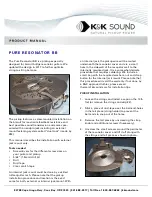
14
10
Introduction
The purpose of the Venus models is to provide an adjustable isothermal enclosure for calibration
purposes. It has been designed to be rugged and easily maintained.
The isothermal enclosure consists of a fixed heater block into which an insert can be
placed. Temperature sensors for calibration are placed in suitably drilled holes in the insert. The
replaceable inserts enable a variety of items to be calibrated.
Additionally there are accessories to allow the calibration of surface sensors and also infrared
thermometers.
The heater block houses a heater and the control sensor used by the temperature controller to
sense the block temperature.
There are two electrically driven fans in the unit. One runs continuously and cools the electronics
in the instrument and the other is switched to cool the block when the set temperature is lower
than the block temperature.
10.1
Comparison Calibration
By definition, one compares industrial thermometers to a calibrated standard. There are three
methods commonly used.
10.2
Basic Operation
Using the controller as the “calibrated standard”. This method means
that the complete bath is calibrated by comparing the controller reading
to a calibrated standard placed in the bath.
This is a common method but is unsafe since the control sensor is
a)
inaccessible
b)
in the wrong place to give correct temperature of the insert
For these reasons it fails to satisfy ISO9000 and gives large uncertainties.
10.3
Site or Self-Contained Calibrators
In these an indicator and external calibrated sensor are used to measure
the temperature of the insert. This arrangement gives good results and
traceability. To recalibrate however it does mean sending the whole
calibrator back to the calibration laboratory. The calibrator is self-
contained, self-sufficient and meets ISO9000 requirements.
Summary of Contents for VENUS 4951 BASIC
Page 28: ...28...















































